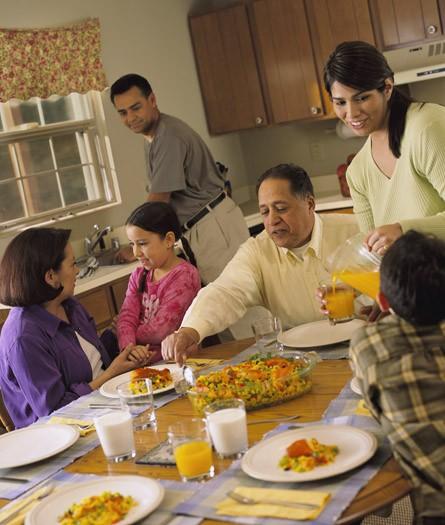Lesson 1.5: Enjoy family meals at home
Background: Today, families enjoy fewer meals together than they did 30 years ago. However, sharing family meals is associated with healthier eating patterns in children and teens. Shared meals can also be relaxed times to talk and help families become closer. Doctors recommend that families eat together at least 3 times a week.

Parents and children share responsibility in making family meals a pleasant experience. Parents decide what to serve and where and when to eat. They do not need to be “short order cooks” who prepare different foods for the adults and children. Children decide whether and how much to eat. While adults can encourage a child to try a small bite of a new food, the child decides whether to ask for more and how much to eat.
Parent role modeling and repeated exposure without force help children learn to like new foods. Parents may not consider threatening to withhold dessert or cartoons until the child eats as ”force”. Yet, such strategies do not teach children to learn to like new foods and can lead to mealtime battles.
Instead, the parent or caregiver should discourage snacks and sugary beverages within an hour before the meal. If possible, they might encourage active play or a walk to build an appetite. Children can help with chores, like setting the table or preparing food.
Teaching Tip: Where both parents work, scheduling regular family meals even 3 times a week may seem impossible.These families might think about planning a picnic for a holiday or Sunday afternoon meal. They might also be able to eat breakfast or lunch together on a weekend.
Target Audience: Latino families with young children, ages 3 to 8 years
Key Message: Eat family meals with foods prepared at home more often.
Objectives: By the end of the lesson, participants will be able to:
1) Explain why family meals prepared at home are important (healthier eating patterns, better performance in school, less risk-taking behavior);
2) Identify three responsibilities of parents (when, where and what to serve); and
3) Identify two responsibilities of children (whether and how much to eat)
Materials:
White board (or post-it papers)
Colored markers
Paper and pencils
Supplies and recipes for food demonstration (suggested Broccoli Quesadillas)
Handouts: Broccoli Quesadillas (English) (Spanish)
Set-up: Place whiteboard or post-it paper in an area visible to all participants.
Click here to download English version lesson plan Lesson 1.5 Enjoy Family Meals at Home (English version)

